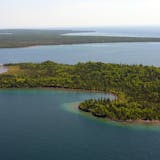Opinion editor's note: Star Tribune Opinion publishes a mix of national and local commentaries online and in print each day. To contribute, click here.
•••
This past December, I read about an impending ecological catastrophe at the Thwaites Glacier in Antarctica. Scientists found evidence that Thwaites is melting much faster than previously anticipated. Without the glacier, which acts much like a cork in a bottle, the Antarctic ice shelf would be free to slide into the sea, potentially raising global sea levels more than 10 feet over the next century. That means no more New York City, no more New Orleans and, you guessed it — no more Miami Beach.
Both Miami Beach and our local Hiawatha Golf Course were heavily engineered during their creation. Miami Beach is built on a narrow strip of land, separated from the city of Miami by Biscayne Bay. In the 1920s, developers built up Miami Beach by dredging the bay, putting landfill on top of the Swiss cheese-like geology of the low-lying island.
Exhibiting the same hubris of that era, Theodore Wirth dredged Rice Lake in Minneapolis and dumped the extra soil into a marsh, creating what we now know as the Hiawatha Golf Course.
When Thwaites melts, Miami Beach will be floating in a watery grave. Similarly, a look in the climate crystal ball shows that Hiawatha Golf Course as it exists today will not be resilient.
We know that Minnesota can expect heavier rainfalls with more intense swings between periods of drought and excessive precipitation. We already saw a once-in-10-year flood at Hiawatha in 2014 that completely derailed a year and a half of golf and sent the Minneapolis Park and Recreation Board begging for help from FEMA. We cannot expect to get another million-dollar federal bailout for the next Hiawatha flood (perhaps as soon as two years from now). The odds of receiving that kind of aid in the future are next to zero.
Miami Beach climate denialists and Hiawatha 18-hole delusionists ignore the inevitable — that our earth is changing in a way that makes it less hospitable to people, and frankly, to golf. Without significant expenditures, extensive damage to the environment and surrounding neighborhood, and massive amounts of human intervention, we are unfortunately not going to engineer our way to an 18-hole solution at Hiawatha.



